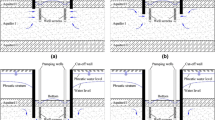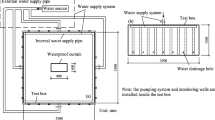Abstract
The vertical–horizontal curtain system (VH curtain) is sometimes utilized in foundation pit dewatering under complex hydrogeological conditions. However, the working mechanism of this system when the horizontal curtain is semi-permeable and cannot completely cut off the bottom aquifer remains unknown. A transparent soil physical model test was performed to reveal the water control mechanism of the VH curtain system with a semi-permeable horizontal curtain. A multi-point inert tracer with a high-speed camera was used to photograph the seepage process. The seepage mode was revealed via a model test. With the Shanghai deep tunnel project as background, a numerical simulation was performed to understand the utilization of the VH curtain. The influence of horizontal curtain position, horizontal curtain thickness, horizontal curtain hydraulic conductivity, and VH curtain combination form on the seepage path around the foundation pit and on the drawdown of water level inside and outside the pit were studied. Results provide a basis for the engineering application of the VH curtain pumping well system.




















Similar content being viewed by others
References
Attard G, Winiarski T, Rossier Y, Eisenlohr L (2016) Review: Impact of underground structures on the flow of urban groundwater. Hydrogeol J 24(1):5–19. https://doi.org/10.1007/s10040-015-1317-3
Chinese industrial white oil industry standard, (2017) No. NB/SH/T 0006–2017, China.
Huang Y, Bao YJ, Wang YH (2015) Analysis of geoenvironmental hazards in urban underground space development in Shanghai. Nat Hazards 75:2067–2079. https://doi.org/10.1007/s11069-014-1414-y
Jurado A, De Gaspari F, Vilarrasa V, Bolster D, Sánchez-Vila X, Fernàndez-Garcia D, Tartakovsky DM (2012) Probabilistic analysis of groundwater-related risks at subsurface excavation sites. Eng Geol 125(1):35–44. https://doi.org/10.1016/j.enggeo.2011.10.015
Liu ZY (2010) Study on dewatering scheme of deep foundation pit with deep and strong permeable layer for Kunming Metro. Railw Surv Des 5:266–270 ((in Chinese))
Lyu HM, Shen SL, Wu YX, Zhou AN (2021) Calculation of groundwater head distribution with a close barrier during excavation dewatering in confined aquifer. Geosci Front 12(2):791–803. https://doi.org/10.1016/j.gsf.2020.08.002
Ni JC, Cheng WC, Ge L (2011) A case history of field pumping tests in a deep gravel formation in the Taipei Basin, Taiwan. Eng Geol 117(1–2):17–28. https://doi.org/10.1016/j.enggeo.2010.10.001
Shanghai Guanglian Environmental & Geotechnical Engineering Co., Ltd. Hydrogeological survey report of Yunling west of lot II, Suzhou river deep drainage regulation and storage pipeline system project (test section), 2017.10
Shen SL, Lyu HM, Zhou AN, Liu LH, Li G, Hu BB (2021) Automatic control of groundwater balance to combat dewatering during construction of a metro system. Automat Constr 123:103536. https://doi.org/10.1016/j.autcon.2020.103536
Shen SL, Wang JP, Wu HN, Xu YS, Ye GL, Yin ZY (2015) Evaluation of hydraulic conductivity for both marine and deltaic deposits based on piezocone testing. Ocean Eng 110:174–182. https://doi.org/10.1016/j.oceaneng.2015.10.011
Shen SL, Wu YX, Xu YS, Hino T, Wu HN (2015) Evaluation of hydraulic parameters from pumping tests in multi-aquifers with vertical leakage in Tianjin. Comput Geotech 68:196–207. https://doi.org/10.1016/J.COMPGEO.2015.03.011
Shen SL, Wu YX, Misra A (2017) Calculation of head difference at two sides of a cut-off barrier during excavation dewatering. Comput Geotech 91:192–202. https://doi.org/10.1016/j.compgeo.2017.07.014
Tan Y, Lu Y, Wang D (2018) Deep excavation of the gate of the orient in Suzhou stiff clay: composite earth-retaining systems and dewatering plans. J Geotech Geoenviron 144(3):05017009
Tan Y, Wei B, Lu Y, Yang B (2019) Is basal reinforcement essential for long and narrow subway excavation bottoming out in Shanghai soft clay? J Geotech Geoenviron 145(5):05019002. https://doi.org/10.1061/(ASCE)GT.1943-5606.0002028
Vilarrasa V, Carrera J, Jurado A, Pujades E, Vázquez-Suné E (2011) A methodology for characterizing the hydraulic effectiveness of an annular low permeability barrier. Eng Geol 120(1–4):68–80. https://doi.org/10.1016/j.enggeo.2011.04.005
Wang JX, Feng B, Liu Y, Wu LG, Zhu YF, Zhang XS, Tang YQ, Yang P (2012) Controlling subsidence caused by de-watering in a deep foundation pit. Bull Eng Geol Environ 71(3):545–555. https://doi.org/10.1007/s10064-012-0420-0
Wang JX, Feng B, Yu HP, Guo TP, Yang GY, Tang JW (2013) Numerical study of dewatering in a large deep foundation pit. Environ Earth Sci 69(3):863–872. https://doi.org/10.1007/s12665-012-1972-9
Wang JX, Huang TR, Sui DC (2013) A case study on stratified settlement and rebound characteristics due to dewatering in Shanghai subway station. Sci World J 2013:213070. https://doi.org/10.1155/2013/213070
Wang JX, Wu YB, Liu XT, Yang TL, Zhu Y (2016) Areal subsidence under pumping well–curtain interaction in subway foundation pit dewatering: conceptual model and numerical simulations. Environ Earth Sci 75:198. https://doi.org/10.1007/s12665-015-4860-2
Wang JX, Deng YS, Ma RQ, Liu XT, Guo QF, Liu SL, Shao YL, Wu LB, Zhou J, Yang TL, Wang HM, Huang XL (2018) Model test on partial expansion in stratified subsidence during foundation pit dewatering. J Hydrol 557:489–508. https://doi.org/10.1016/j.jhydrol.2017.12.046
Wang HY (2013) Construction technology and effect analysis of horizontal curtain grouting in sandy cobble stratum. Water Conserv Hydropower Constr 1:65–70 ((in Chinese))
Wang CY, Sun LX (2004) Analysis and calculation of horizontal impervious curtain thickness of deep foundation pit. Shandong Water Conserv 6:44–45 ((in Chinese))
Wu YX, Shen SL, Xu YS, Yin ZY (2015) Characteristics of groundwater seepage with cut-off wall in gravel aquifer. I: field observations. Can Geotech J 52(10):1526–1538. https://doi.org/10.1139/cgj-2014-0285
Wu YX, Shen SL, Yin ZY, Xu YS (2015) Characteristics of groundwater seepage with cut-off wall in gravel aquifer. II: numerical analysis. Can Geotech J 52(10):1539–1549. https://doi.org/10.1139/cgj-2014-0289
Wu HN, Shen SL, Yang J (2017) Identification of tunnel settlement caused by land subsidence in soft deposit of Shanghai. ASCE J Perform Constr Facil 31(6):04017092. https://doi.org/10.1061/(ASCE)CF.1943-5509.0001082
Wu YX, Lyu HM, Shen JS, Arulrajah A (2018) Geological and hydrogeological environment in Tianjin with potential geohazards and groundwater control during excavation. Environ Earth Sci 77:392. https://doi.org/10.1007/s12665-018-7555-7
Wu YX, Lyu HM, Han J, Shen SL (2019) Dewatering-induced building settlement around a deep excavation in the soft deposit of Tianjin, China. J Geotech Geoenviron Eng ASCE 145(5):05019003. https://doi.org/10.1061/(ASCE)GT.1943-5606.0002045
Wu YX, Shen SL, Yuan DJ (2016) Characteristics of dewatering induced drawdown curve under blocking effect of retaining wall in aquifer. J Hydrol 539:554–566
Xu YS, Shen SL, Du YJ (2009) Geological and hydrogeological environment in Shanghai with geohazards to construction and maintenance of infrastructures. Eng Geol 109(3–4):241–254. https://doi.org/10.1016/j.enggeo.2009.08.009
Xu YS, Wu HN, Wang BZ, Yang TL (2017) Dewatering induced subsidence during excavation in a Shanghai soft deposit. Environ Earth Sci 76(9):351. https://doi.org/10.1007/s12665-017-6685-7
Xu YS, Shen SL, Ren DJ, Wu HN, A. Rosen M, (2016) Factor analysis of land subsidence in Shanghai: a view based on strategic environmental assessment. Sustainability 8:573. https://doi.org/10.3390/su8060573
Xu YS, Shen JS, Zhou AN, Arulrajah A (2018) Geological and hydrogeological environment with geohazards during underground construction in Hangzhou: a review. Arab J Geosci 11(18):544. https://doi.org/10.1007/s12517-018-3894-7
Xu YS, Yan XX, Shen SL, Zhou AN (2019) Experimental investigation on the blocking of groundwater seepage from a waterproof curtain during pumped dewatering in an excavation. Hydrogeol J 27(7):2659–2672. https://doi.org/10.1007/s10040-019-01992-3
Yan S, Zhang L, Zhao L, Sang L, Zhang GY (2013) Application and effect analysis of horizontal curtain grouting in sandy cobble stratum. Water Conserv Hydropower Technol 44(2):82–89 ((in Chinese))
Zeng CF, Xue XL, Zheng G, Xue TY, Mei GX (2018) Responses of retaining wall and surrounding ground to pre-excavation dewatering in an alternated multi-aquifer-aquitard system. J Hydrol 559:609–626. https://doi.org/10.1016/j.jhydrol.2018.02.069
Zeng CF, Xue XL, Li MK (2021) Use of cross wall to restrict enclosure movement during dewatering inside a metro pit before soil excavation. Tunn Undergr Space Technol 112:103909. https://doi.org/10.1016/j.tust.2021.103909
Zeng CF, Powrie W, Xue XL, Li MK, Mei GX (2021) Effectiveness of a buttress wall in reducing retaining wall movement during dewatering before bulk excavation. Acta Geotech 16:3253–3267. https://doi.org/10.1007/s11440-021-01179-9
Zeng CF, Song WW, Xue XL, Li MK, Bai N, Mei GX (2021) Construction dewatering in a metro station incorporating buttress retaining wall to limit ground settlement: insights from experimental modelling. Tunn Undergr Space Technol 116:104124. https://doi.org/10.1016/j.tust.2021.104124
Zeng CF, Wang S, Xue XL, Zheng G, Mei GX (2021) Evolution of deep ground settlement subject to groundwater drawdown during dewatering in a multi-layered aquifer-aquitard system: insights from numerical modelling. J Hydrol 603:127078. https://doi.org/10.1016/j.jhydrol.2021.127078
Zeng CF, Zheng G, Zhou XF, Xue XL, Zhou HZ (2019) Behaviours of wall and soil during pre-excavation dewatering under different foundation pit widths. Comput Geotech 115:103169. https://doi.org/10.1016/j.compgeo.2019.103169
Zeng CF, Zheng G, Xue XL (2019) Responses of deep soil layers to combined recharge in a leaky aquifer. Eng Geol 260:105263. https://doi.org/10.1016/j.enggeo.2019.105263
Zeng CF, Zheng G, Xue XL, Mei GX (2019) Combined recharge: a method to prevent ground settlement induced by redevelopment of recharge wells. J Hydrol 568:1–11. https://doi.org/10.1016/j.jhydrol.2018.10.051
Acknowledgements
This research was funded by the Shanghai Municipal Science and Technology Project (18DZ1201301; 19DZ1200900); Shanghai Municipal Science and Technology Major Project (2021SHZDZX0100) and the Fundamental Research Funds for the Central Universities; Laboratory of Impact and Safety Engineering (Ningbo University), Ministry of Education (CJ202101); Key Laboratory of Land Subsidence Monitoring and Prevention, Ministry of Natural Resources of the People’s Republic of China (No. KLLSMP202101); the National Natural Science Foundation of China (Grant No. 41907230); Xiamen Road and Bridge Group (XM2017-TZ0151; XM2017-TZ0117); the project of Key Suzhou Rail Transit Line 1 Co. Ltd, China Railway 15 Bureau Group Co. ltd.
Author information
Authors and Affiliations
Corresponding author
Ethics declarations
Conflict of interest
The authors declared that there is no conflict of interest.
Additional information
Publisher's Note
Springer Nature remains neutral with regard to jurisdictional claims in published maps and institutional affiliations.
Supplementary Information
Below is the link to the electronic supplementary material.
Supplementary file1 (AVI 90693 kb)
Rights and permissions
About this article
Cite this article
Wang, J., Long, Y., Gao, F. et al. Transparent soil test evaluation of vertical–horizontal mixed curtain during dewatering. Acta Geotech. 17, 3293–3313 (2022). https://doi.org/10.1007/s11440-021-01436-x
Received:
Accepted:
Published:
Issue Date:
DOI: https://doi.org/10.1007/s11440-021-01436-x




